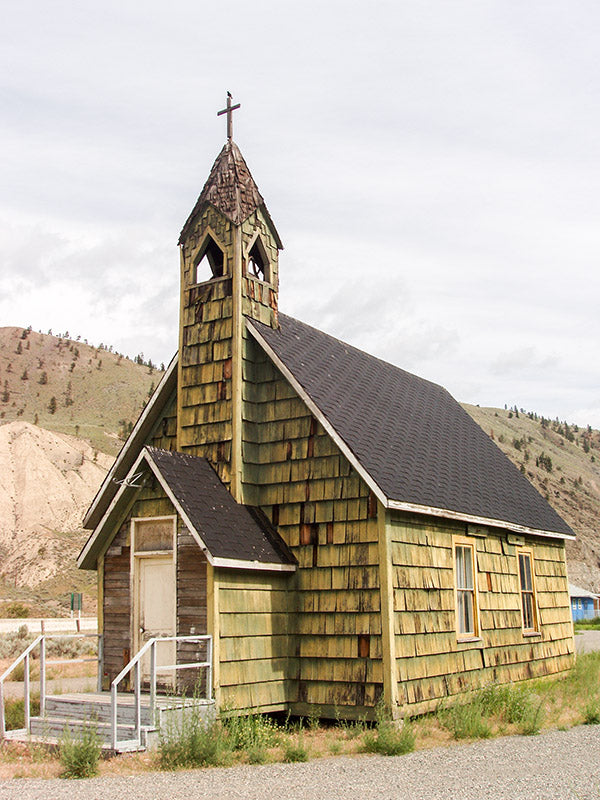








Heritage Churches of the Indigenous Peoples of British Columbia: Historical Events & Architectural Elements of Church Structures
Details
By: Kenneth E. Perry
ISBN-13: 978-0-88839-074-5 [trade softcover]
ISBN-13: 978-0-88839-304-3 [epub]
Binding: Trade Paper
Size: 8.5" X 11"
Pages: 240
Photos: 300
Publication Date: February 2020
Description
Heritage Churches of the Indigenous Peoples of British Columbia - chronicles existing church structures that dot the Indigenous landscape across what was once, a wild frontier and a thriving fur-trading empire. A beautifully illustrated work, with over three hundred colour photographs that will take the reader into urban, rural and remote areas of our beautiful Province of British Columbia.
From Captain’s Vancouver’s Island, and beyond to the picturesque Gulf Islands, Lower Mainland and the famed Sunshine Coast; all revealing the rich culture of the Indigenous Peoples throughout each region.
Equally enchanting, is the winding trek over coastal and inland mountain passes to the semi-arid Southern Interior and the snow-capped Rocky Mountains of the Kootenay region, both in their own right boasting of great lakes and spectacular views. From this point, one sets course northward to the famous gold rush regions of the Cariboo plateau and upper reaches of the far north.
This new book is very informative, historically interesting and well documented through pictures, combining local history, architectural church elements and a legacy of Indigenous carpentry skills on a grand scale. Over ninety churches reveal an evolution of building traditions spanning a period of more than one hundred and forty years.
Each one of these old churches has a story to tell and a legacy to reveal. In this case, the story is about local history while brief in content and the legacy is about preserving through pictures the architectural elements of church structures.
This fascinating work is indeed for all ages and cultures, a remarkable read and highly recommended for our time and the generations yet to come.
Author Biography
 During his tour of duty there, he became a Black Belt Judo Instructor and participated in many Judo Tournaments that took him and his fellow team-mates to numerous military bases in West Germany, France, and England. Soon after Ken’s return to Canada in 1967, he was Honourably Released from the Armed Forces. Five weeks later he was hired on with a Canadian National and International Heavy Equipment Company; after 41 years of service with this firm he retired. Ken is a father of one son and one daughter, and a Grandfather of five wonderful Grand Children.
During his tour of duty there, he became a Black Belt Judo Instructor and participated in many Judo Tournaments that took him and his fellow team-mates to numerous military bases in West Germany, France, and England. Soon after Ken’s return to Canada in 1967, he was Honourably Released from the Armed Forces. Five weeks later he was hired on with a Canadian National and International Heavy Equipment Company; after 41 years of service with this firm he retired. Ken is a father of one son and one daughter, and a Grandfather of five wonderful Grand Children.Reviews
Publishers Note
Over 150,000 First Nations children attended some 132 residential schools established across Canada by the Canadian government and with the help of the Catholic, United, Anglican and Presbyterian churches between 1857 and 1996. While intentions of these groups at the time may have been honourable, and likely in some cases, less so, the ultimate result was a severe loss and extinction of some Indigenous cultural elements, including language, art and other cultural expressions- including First Nations religious practices.
As a publishing house with a long history of producing works with Indigenous content, particularly focusing on the Pacific Northwest region, we were initially hesitant of pursuing this title given the justifiable scrutiny that religious organisations have faced in regards to their historic treatment of First Nations Peoples and the role that churches played during this time.
After some careful consideration, we believed the author demonstrated a true desire to showcase some of the unique architectural and historic elements of many of these old structures that were slowly returning back to the earth from which they were originally derived. Given no other publication that we could find had made such a strong attempt to capture these old buildings in written or photographic form, we believed this represented an opportunity to ensure that whatever unique Indigenous elements that had been incorporated into these buildings was not lost as well.
We hope the reader, particularly the Indigenous ones, might be able to glean some sense of appreciation and interest in the convergence of the colonial and Aboriginal cultures and how these were expressed at a local level at each one of these churches. These historic buildings may also act as a reminder of how societal and cultural believes and perspectives have changed over time.